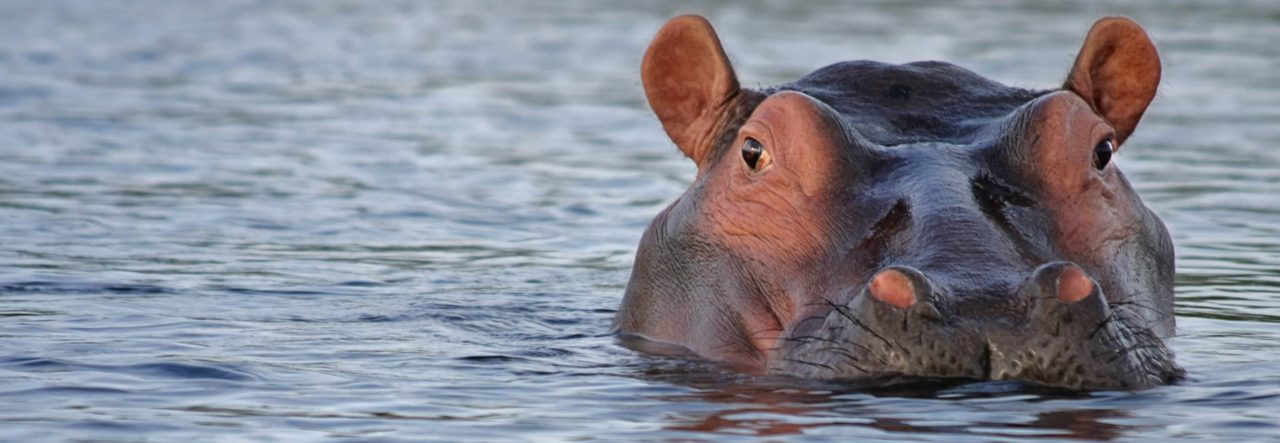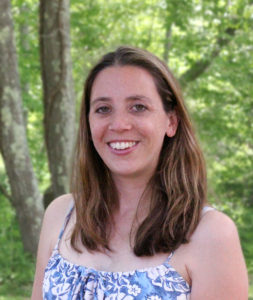 We’re starting off 2022 with an author/illustrator interview with OPB contributor Abi Cushman. Among her many talents, she’s a web designer, so we won’t ask her to critique the OPB site! She also runs a few non-kidlit websites, which we’ll talk about in the interview. Perhaps more relevant for our interview is this—she’s partnered on picture book reviews here at OPB, and she’s the author/illustrator of two fine picture books, Soaked! and Animals Go Vroom!, both from Viking Children’s Books.
We’re starting off 2022 with an author/illustrator interview with OPB contributor Abi Cushman. Among her many talents, she’s a web designer, so we won’t ask her to critique the OPB site! She also runs a few non-kidlit websites, which we’ll talk about in the interview. Perhaps more relevant for our interview is this—she’s partnered on picture book reviews here at OPB, and she’s the author/illustrator of two fine picture books, Soaked! and Animals Go Vroom!, both from Viking Children’s Books.
Abi lives with her family in a small Connecticut beach town. Sounds positively charming, doesn’t it?
Let’s get to that interview so we can learn even more about Abi Cushman!
RVC: Let’s start things off by addressing the elephant rabbit in the room. You run a website about rabbits. How’d that come about?
AC: Well, just like some people are dog people and others are cat people, I’ve always been a rabbit person. As it happens, my husband also had a rabbit growing up. So, when we moved in together, we of course adopted pet rabbits. Since I’m a web designer, we decided to start a website sharing everything we learned about house rabbits: how to litterbox-train them, how to protect your belongings from being chewed, what a binky is, and why it’s important to keep pet rabbits inside the house and not outside in a hutch.
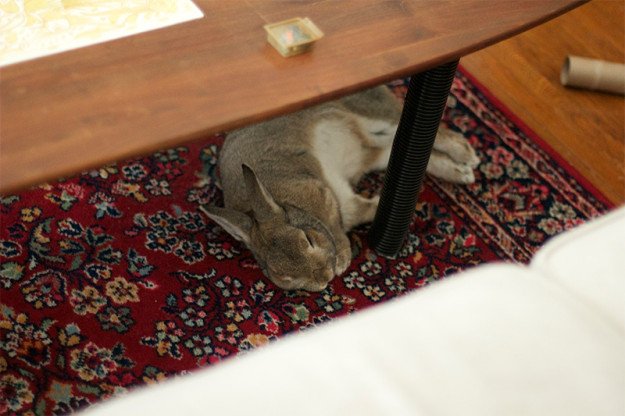
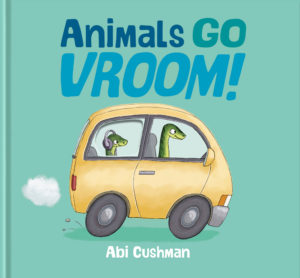 RVC: I’m now wondering if this interest in animals led to your second picture book, Animals Go Vroom!.
RVC: I’m now wondering if this interest in animals led to your second picture book, Animals Go Vroom!.
AC: I’ve always been interested in animals, and I really only like drawing animals. So, my stories so far have always centered around animal characters. Animals Go Vroom! came about when I drew this character in my sketchbook:

It made me think about vehicles and animals making the same sound.
RVC: Was using die-cuts in that book your idea or did it come about in the editorial process?
AC: The die-cuts were a major part of my vision for this book from the start. I was reading a ton of novelty board books to my son who was a toddler at the time. And I loved that many of them had a guessing-game element to them and used either die-cuts or lift the flaps to provide a fun reveal. When I started playing around with the idea of animal and vehicle sounds overlapping, I thought that die-cuts would be the perfect way to give a peek at the next page before revealing the true source of each sound.
RVC: What was the best lesson that book taught you?
AC: Making this book was really challenging design-wise because each of the die-cuts had to line up on two spreads while the illustrations were telling a chain-of-events story of a worsening traffic jam. But it was really satisfying using the page turns plus die-cut holes to create an interactive experience for the reader. The best lesson was the importance of making a physical book dummy to test and refine the experience of turning the pages and having everything line up properly.
RVC: Let’s hop (like that bunny reference?) back to the beginning. When did you first develop an interest in art?
AC: I’ve always loved drawing. Growing up, I mostly focused on trying to draw and paint animals realistically. My parents were very encouraging of my art and gave me lots of art supplies. I was very fortunate that I had the opportunity to play around with charcoals, pastels, watercolors, and acrylic paints.
RVC: What about your interest in writing?
AC: I never really thought of myself as a writer. But I did love the idea of making picture books. My dream growing up was to become an illustrator. So, when I was a kid, I’d make up stories for the sheer purpose of having something to illustrate. It’s funny how that actually hasn’t changed now that I’m an adult. I’m still creating stories so that I can illustrate them. I broke into the publishing industry by becoming an author-illustrator and pitching my own stories.
RVC: What kind of training did you have in both areas along the way?
AC: I took art classes in high school and minored in Studio Art in college. But I really developed my illustration style and skills after college. A lot of it really is just practice and the ability to look at other people’s illustrations and analyze what is working, and if there’s something you could incorporate into your own work. It’s also about being able to look at your own work and seeing where you could improve or try new things.
In terms of writing, I didn’t have any formal training until I enrolled in Storyteller Academy in 2016. I learned how to break down character-based stories and how to incorporate drawing into the process of making a story. That really was a turning point for me because trying to make an interesting story by typing a manuscript on a computer just wasn’t working.
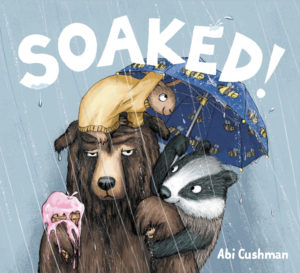 RVC: Let’s talk about your author-illustrator debut, Soaked, which is about a particularly grumpy bear and some foul weather. But it’s more than that, isn’t it?
RVC: Let’s talk about your author-illustrator debut, Soaked, which is about a particularly grumpy bear and some foul weather. But it’s more than that, isn’t it?
AC: At its heart, Soaked! is about changing your perspective even when the situation doesn’t change. It’s about finding the silver lining. It’s about finding joy through play. It’s about being there as a friend even if you’re feeling grumpy or your friend is feeling grumpy.
RVC: I want you to respond to three words (two, really, since a pair of them are a hyphenated compound adjective). “Hula-hooping moose.”
AC: Life goals. Seriously… Hula-hooping Moose [a fun character in Soaked!] is living his best life.
RVC: In all your experience with that book—from initial idea to a finished book being on the shelf—what surprised you the most?
AC: I spent several months working on the story and revising it before it sold to Viking, and then I worked on more edits with my editor and art director. But what surprised me was how little the beginning of the book changed from my initial braindump. Another big surprise was how long it took me to complete the final illustrations. With it being my first book, I wanted everything to be perfect. So, I think I spent 9 months drawing and redrawing, fiddling with the colors, etc. And then of course, when it prints, the colors look different than what’s on my screen anyway.
RVC: I’m probably playing Dr. Obvious here, but I notice that 100% of your picture book titles end with exclamation points. Purposeful or coincidental?
AC: There was always an exclamation point in Animals Go Vroom!, but Soaked! originally did not have an exclamation point in it. It was added after the Sales team at Penguin saw our proposed cover design and asked if we’d add one.
But yes, I’m very cognizant of the fact that my two books both have punctuation in the titles because when I’m writing about them, my word processor always automatically capitalizes the next word as if I’m starting a new sentence, and it’s very annoying. If only I had known this would haunt me in every written interview or blog post!
RVC: Creating a picture book is challenging. What do you do when you find yourself getting distracted or going off track?
AC: Well, creativity does need time and space sometimes. So, I might switch gears and do some cleaning around the house or go for a run or even write answers to interview questions like I’m doing now. But if there are deadlines, I will try to buckle down and get it done. I’ve found that it really helps to just start. The biggest challenge is facing the blank page. I just try to put something–anything– down on paper. And then my natural inclination to try to fix things kicks in, and I’ll get into a groove.
RVC: What’s your process for making the first draft of an author/illustrated picture book?
AC: First I doodle a lot in what I call my Ugly Sketchbook. It’s a place where I keep all my good story ideas mixed in with a ton of bad ones. I use a regular gel pen to ensure I don’t get too precious about what the art looks like. Along with the doodles, I also write down jokes or bits of dialogue. Eventually, I’ll take all my little drawings and pieces of text and organize them into thumbnails. Then I’ll make a mini dummy by cutting some printer paper in half and then folding that in half. This helps me figure out if the pacing is working. It’s good to see the page turns in action. It’s this mini dummy that I show to my critique group and my agent.

RVC: My art students (my writing classes at Ringling College of Art and Design get tons of visual arts majors in them) are digital natives, so they’re generally most comfortable producing everything digitally via Photoshop, Illustrator, Procreate, Wacom tablets, etc. How do you produce your art?
AC: I really like the feel of pencil on paper. So, I do all my drawing with a mechanical pencil on printer paper. Then I scan it in, and use a tablet and Photoshop to color the final art. I like this hybrid way of working because I can still feel the joy of creating marks on paper, but I have all the benefits of the digital environment–moving things around, changing colors, and fixing mistakes. For me, the most important thing is that I feel comfortable making the art, and that I’m pleased with the final product. It doesn’t really matter how you reach that point, so my advice to people is to just do what works for them.
RVC: Both of your books came out during or right around the pandemic. How did that affect your PR efforts?
AC: Yes, Soaked! came out in the summer of 2020 when a lot of bookstores were closed. That was definitely disappointing. I had planned a big in-person launch party plus local bookstore storytimes, which of course never happened. And then I naively thought that by the time Animals Go Vroom! came out in 2021, the pandemic would be winding down.
Luckily, I had promotional activities planned that didn’t involve being in-person, like doing blog interviews and guest posts. I’m also part of a book marketing group called the Soaring ’20s, and we review each other’s books, host giveaways, organize group panel discussions for virtual conferences, and boost each other on social media.
People in my town have also been wonderfully supportive. My local librarian featured both of my books on our town’s Storybook Trail, where each page spread is printed onto a sign, and people can read the book as they walk along a path in the town park. The local paper also did a couple articles about me and my books.
RVC: Author newsletters. Worth the trouble or not?
AC: I do write a monthly-ish newsletter. When I write them, I try to think of it like I’m writing to a specific friend–someone who’s interested in what I’ve got going on, but also appreciates my jokes. A lot of people aren’t on social media, and my email is the only way they find out about my new books and what I did when I discovered a skunk walking around my kitchen at 1am.
RVC: One last question for this part of the interview. What’s in the pipeline for you? Any new projects you want to tease us about?
AC: It hasn’t been announced yet, but I’m currently working on edits for an informational picture book coming out in 2023. It’s a new experience for me because, while I always use reference when I illustrate (even if I’m drawing a mouse riding a unicycle), this book requires even more diligence in that respect. I want to make sure I’m representing the subject matter accurately in both the words and the pictures. So, I’ve been knee-deep in scientific studies lately, while also agonizing over the best word choice for some poop jokes.
RVC: There’s no good segue away from poop jokes (which ARE hilarious, by the way), so I’ll just say…Abi, you’ve been a part of OPB for some time, so this should come as no surprise. It’s time for the SPEED ROUND! Comet-fast questions and asteroid-swift answers, please! Are you ready?
AC: Ready!
RVC: Funniest animal fact you bring out at dinner parties?
AC: Wombats poop cubes.
RVC: What animal would be cutest if it were shrunk to the size of a cat?
AC: A hippo.
RVC: If you had a giraffe that you needed to hide, where you would hide it?
AC: Amongst my other giraffes.
RVC: Favorite author/illustrator picture book of 2021?
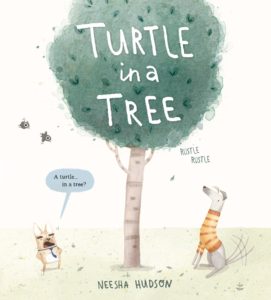 AC: Turtle in a Tree by Neesha Hudson.
AC: Turtle in a Tree by Neesha Hudson.
RVC: Your illustration philosophy in six words or fewer?
AC: Yes, that otter needs a monocle.
RVC: Best compliment you’ve ever received on your picture books?
AC: One kid commented after I read Soaked!: “That was really weird… but really funny.” That kid gets it.
RVC: It’s always great to have you join us at OPB, Abi. Thanks for sharing your story with us!
AC: Thank you, Ryan! Always a pleasure being here.

